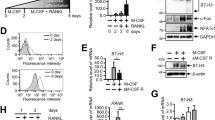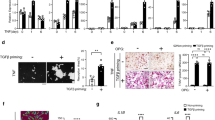Abstract
Bone resorption is regulated by the immune system1,2, where T-cell expression of RANKL (receptor activator of nuclear factor (NF)-κB ligand), a member of the tumour-necrosis factor family that is essential for osteoclastogenesis, may contribute to pathological conditions, such as autoimmune arthritis3,4. However, whether activated T cells maintain bone homeostasis by counterbalancing the action of RANKL remains unknown. Here we show that T-cell production of interferon (IFN)-γ strongly suppresses osteoclastogenesis by interfering with the RANKL–RANK signalling pathway. IFN-γ induces rapid degradation of the RANK adapter protein, TRAF6 (tumour necrosis factor receptor-associated factor 6), which results in strong inhibition of the RANKL-induced activation of the transcription factor NF-κB and JNK. This inhibition of osteoclastogenesis is rescued by overexpressing TRAF6 in precursor cells, which indicates that TRAF6 is the target critical for the IFN-γ action. Furthermore, we provide evidence that the accelerated degradation of TRAF6 requires both its ubiquitination, which is initiated by RANKL, and IFN-γ-induced activation of the ubiquitin–proteasome system. Our study shows that there is cross-talk between the tumour necrosis factor and IFN families of cytokines, through which IFN-γ provides a negative link between T-cell activation and bone resorption. Our results may offer a therapeutic approach to treat the inflammation-induced tissue breakdown.
This is a preview of subscription content, access via your institution
Access options
Subscribe to this journal
Receive 51 print issues and online access
$199.00 per year
only $3.90 per issue
Buy this article
- Purchase on SpringerLink
- Instant access to full article PDF
Prices may be subject to local taxes which are calculated during checkout




Similar content being viewed by others
References
Roodman, G. D. Cell biology of the osteoclast. Exp. Hematol. 27, 1229–1241 (1999).
Suda, T. et al. Modulation of osteoclast differentiation and function by the new members of the tumor necrosis factor receptor and ligand families. Endocr. Rev. 20, 345–357 (1999).
Kong, Y. Y. et al. OPGL is a key regulator of osteoclastogenesis, lymphocyte development and lymph-node organogenesis. Nature 397, 315–323 (1999).
Kong, Y. Y. et al. Activated T cells regulate bone loss and joint destruction in adjuvant arthritis through osteoprotegerin ligand. Nature 402, 304–309 (1999).
Takayanagi, H. et al. Suppression of arthritic bone destruction by adenovirus-mediated csk gene transfer to synoviocytes and osteoclasts. J. Clin. Invest. 104, 137–146 (1999).
Horwood, N. J. et al. Activated T lymphocytes support osteoclast formation in vitro. Biochem. Biophys. Res. Commun. 265, 144–150 (1999).
Takahashi, N., Mundy, G. R. & Roodman, G. D. Recombinant human interferon-γ inhibits formation of human osteoclast-like cells. J. Immunol. 137, 3544–3549 (1986).
Udagawa, N. et al. Interleukin-18 (interferon-γ-inducing factor) is produced by osteoblasts and acts via granulocyte/macrophage colony-stimulating factor and not via interferon-γ to inhibit osteoclast formation. J. Exp. Med. 185, 1005–1012 (1997).
Ukai, T., Hara, Y. & Kato, I. Effects of T cell adoptive transfer into nude mice on alveolar bone resorption induced by endotoxin. J. Periodontal. Res. 31, 414–422 (1996).
Chiang, C. Y., Kyritsis, G., Graves, D. T. & Amar, S. Interleukin-1 and tumor necrosis factor activities partially account for calvarial bone resorption induced by local injection of lipopolysaccharide. Infect. Immun. 67, 4231–4236 (1999).
Huang, S. et al. Immune response in mice that lack the interferon-γ receptor. Science 259, 1742–1745 (1993).
Manoury-Schwartz, B. et al. High susceptibility to collagen-induced arthritis in mice lacking IFN-γ receptors. J. Immunol. 158, 5501–5506 (1997).
Vermeire, K. et al. Accelerated collagen-induced arthritis in IFN-γ receptor-deficient mice. J. Immunol. 158, 5507–5513 (1997).
Stark, G. R., Kerr, I. M., Williams, B. R., Silverman, R. H. & Schreiber, R. D. How cells respond to interferons. Annu. Rev. Biochem. 67, 227–264 (1998).
Taniguchi, T., Lamphier, M. S. & Tanaka, N. IRF-1: the transcription factor linking the interferon response and oncogenesis. Biochim. Biophys. Acta 1333, M9–M17 (1997).
Wong, B. R. et al. The TRAF family of signal transducers mediates NF-κB activation by the TRANCE receptor. J. Biol. Chem. 273, 28355–28359 (1998).
Lomaga, M. A. et al. TRAF6 deficiency results in osteopetrosis and defective interleukin-1, CD40, and LPS signaling. Genes Dev. 13, 1015–1024 (1999).
Naito, A. et al. Severe osteopetrosis, defective interleukin-1 signalling and lymph node organogenesis in TRAF6-deficient mice. Genes Cells 4, 353–362 (1999).
Baumeister, W., Walz, J., Zuhl, F. & Seemuller, E. The proteasome: paradigm of a self-compartmentalizing protease. Cell 92, 367–380 (1998).
Tanaka, K. & Kasahara, M. The MHC class I ligand-generating system: roles of immunoproteasomes and the interferon-γ-inducible proteasome activator PA28. Immunol. Rev. 163, 161–176 (1998).
Preckel, T. et al. Impaired immunoproteasome assembly and immune responses in PA28-/- mice. Science 286, 2162–2165 (1999).
Tanahashi, N. et al. Hybrid proteasomes. Induction by interferon-γ and contribution to ATP-dependent proteolysis. J. Biol. Chem. 275, 14336–14345 (2000).
Firestein, G. S. & Zvaifler, N. J. How important are T cells in chronic rheumatoid synovitis? Arthritis Rheum. 33, 768–773 (1990).
Kinne, R. W., Palombo-Kinne, E. & Emmrich, F. T-cells in the pathogenesis of rheumatoid arthritis: villains or accomplices? Biochim. Biophys. Acta 1360, 109–141 (1997).
Takayanagi, H. et al. Involvement of receptor activator of nuclear factor κB ligand/osteoclast differentiation factor in osteoclastogenesis from synoviocytes in rheumatoid arthritis. Arthritis Rheum. 43, 259–269 (2000).
Gravallese, E. M. et al. Synovial tissue in rheumatoid arthritis is a source of osteoclast differentiation factor. Arthritis Rheum. 43, 250–258 (2000).
Billiau, A. Interferon-γ: biology and role in pathogenesis. Adv. Immunol. 62, 61–130 (1996).
Matsuyama, T. et al. Targeted disruption of IRF-1 or IRF-2 results in abnormal type I IFN gene induction and aberrant lymphocyte development. Cell 75, 83–97 (1993).
Meraz, M. A. et al. Targeted disruption of the Stat1 gene in mice reveals unexpected physiologic specificity in the JAK-STAT signaling pathway. Cell 84, 431–442 (1996).
Yasuda, H. et al. Osteoclast differentiation factor is a ligand for osteoprotegerin/osteoclastogenesis-inhibitory factor and is identical to TRANCE/RANKL. Proc. Natl Acad. Sci. USA 95, 3597–3602 (1998).
Acknowledgements
We thank J. Inoue for the gift of TRAF6 cDNA; T. Kitamura for the pMX vectors; E. Barsoumian for critical reading of the manuscript; I. Kawai for assistance; and M. Asagiri for discussion. This work was supported by a grant for Advanced Research on Cancer from the Ministry of Education, Science, Sports and Culture of Japan; a research fellowship of the Japan Society for the Promotion of Science for Young Scientists; Health Sciences Research Grants from the Ministry of Health and Welfare of Japan; and a grant from Japan Orthopaedics and Traumatology Foundation.
Author information
Authors and Affiliations
Corresponding author
Rights and permissions
About this article
Cite this article
Takayanagi, H., Ogasawara, K., Hida, S. et al. T-cell-mediated regulation of osteoclastogenesis by signalling cross-talk between RANKL and IFN-γ. Nature 408, 600–605 (2000). https://doi.org/10.1038/35046102
Received:
Accepted:
Issue Date:
DOI: https://doi.org/10.1038/35046102



